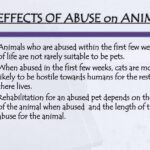When we contemplate the concept of animal cruelty, we often picture overt acts of violence or open maltreatment. However, the reality is that animal cruelty is a complex and multifaceted phenomenon encompassing a spectrum of behaviors that can be both insidious and overt. From neglect to exploitation, each type underscores the pressing need for awareness and action. But how many different types of animal cruelty exist, and what implications do they carry for society and the climate of animal welfare?
At the outset, it is crucial to delineate the primary categories of animal cruelty. The two overarching classifications are active cruelty and passive cruelty. Active cruelty involves direct harm inflicted on animals, while passive cruelty typically relates to neglect or a failure to provide necessary care. Understanding these distinctions is essential for identifying how cruelty can manifest in diverse forms.
Active Cruelty: Violence and Intentional Abuse
Active cruelty often conjures images of heinous acts, such as physical violence or abandonment. These actions can include but are not limited to:
- Physical Abuse: This involves striking, choking, or otherwise physically assaulting animals. The physical damage can be severe, leading to lasting trauma, injury, or even death.
- Sexual Abuse: A particularly disturbing facet of active cruelty, sexual abuse of animals manifests in various forms, ranging from coercion to exploitation.
- Animal Fighting: This brutal form of active cruelty involves forcing animals to fight for entertainment or profit. Often glamorized in popular culture, dog fighting and cockfighting represent not just individual acts of cruelty but also the systemic issues that perpetuate them.
Active cruelty often evokes strong emotional responses and garners public outrage. However, to combat these egregious behaviors effectively, it is imperative to also understand passive cruelty.
Passive Cruelty: Neglect and Inattention
Passive cruelty may not evoke the same visceral disgust as its active counterpart, but it is equally damaging. Neglect can lead to profound suffering, often more quietly. The forms of passive cruelty include:
- Neglect: Failing to provide sufficient food, potable water, shelter, and medical care represents the most common form of passive cruelty. Many animals suffer silently in homes where their basic necessities are neglected, leading to malnutrition, dehydration, and illness.
- Abandonment: Leaving animals to fend for themselves is not merely an act of neglect—it can also be seen as a deliberate abandonment of responsibility. Stray and feral animals often endure extreme hardship as a result.
- Overcrowding: Inadequate living conditions can lead to overcrowding, where animals are confined together in unhygienic and stressful environments. This often exacerbates health problems and mental distress among affected animals.
Passive cruelty is pervasive in situations such as hoarding, where individuals accumulate more animals than they can care for properly. This form of cruelty illustrates a tragic disparity between intended love and the actual capacity to provide care.
Exploitation: The Commercial Aspect of Cruelty
Beyond neglect and active abuse, exploitation represents another significant domain of animal cruelty. These practices often occur within various industries and can perpetuate systemic forms of cruelty.
- Factory Farming: One of the most widespread forms of animal exploitation, factory farming prioritizes profit over animal welfare. Animals are often confined to cramped quarters, deprived of natural behaviors, and subjected to inhumane treatment.
- Entertainment Industry: Many animals are exploited in the entertainment sector, enduring harsh training regimes and forced performances. Circuses, zoos, and marine parks can invoke extreme distress and suffering, often hidden from public view.
- Fashion Industry: The use of animal products in fashion, from leather to fur, raises significant ethical concerns. The practices involved in acquiring these materials can often result in significant suffering for the animals involved.
Each of these forms of exploitation is a reminder of the societal structures that propagate animal cruelty under the guise of entertainment, industry, or tradition. Tackling these issues requires transformative actions—from advocacy to legislation and consumer responsibility.
The Role of Awareness and Advocacy
Given the diverse manifestations of animal cruelty, raising awareness is paramount. The challenge lies in fostering empathy and understanding around lesser-known forms of cruelty, such as passive neglect and systemic exploitation. This necessitates a call to action: how can we, as individuals and a society, shift the narrative surrounding animal welfare?
Engagement with advocacy organizations, education on responsible pet ownership, and informed consumer choices can be pivotal in addressing animal cruelty in its many forms. Collective actions, from legislative changes to grassroots campaigns, are essential to mitigating cruelty and ensuring that animals are treated with dignity and respect.
In conclusion, the question of how many types of animal cruelty exist is not merely academic; it is a reflection of our values and priorities as a society. By exploring the intricate layers of cruelty—from active abuse to passive neglect and exploitation—we can begin to dismantle the systems that allow such suffering to persist. Awareness is the first step toward change; each of us has a role to play in advocating for a world where animals are safeguarded from harm.








